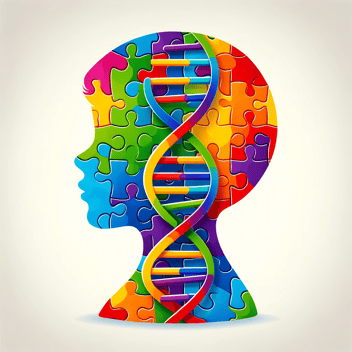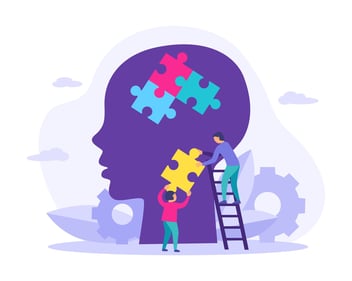Navigating Autism Spectrum Disorder: A Breakdown by Age Group
- Home
- Blog

At least one in 36 children in the U.S. has autism. For parents, caring for a child with autism can be confusing and overwhelming. Whether you’re already parenting a child with autism or starting to recognize early signs, you need the right resources and strategies to provide support from early childhood to the teenage years.
Keep reading to learn what autism is, how it manifests differently across age groups, and what we can do to help.
What Is Autism Spectrum Disorder?
Autism spectrum disorder (ASD) is a developmental condition that can lead to significant social, communication, and behavioral challenges. It is believed to be the result of a complex combination of genetic and environmental factors, such as genetics, gut health, the immune system, and stress markers.
Children with autism exhibit unique combinations of signs and symptoms, which can be triggered by stimuli and influenced by numerous underlying root causes. Identifying and addressing the root causes of autism allows us to tailor more effective, personalized treatment plans to each individual.
Breaking Down Autism by Age Group
Age plays an important role in how autism manifests and how it’s evaluated. Early detection is crucial for securing proper treatment and can potentially reduce challenging behaviors, improve socialization, and help restore certain skills that may have been lost.
Here’s a breakdown of autism by age group with signs and symptoms to look for:
Young Children (18 months-5 years)
Preschool-age children can exhibit signs of autism early on, and screening for autism begins as young as 18 months old. Common signs to look for include avoiding eye contact, displaying repetitive or stereotypical behaviors such as lining up toys, ignoring others when called by their name, limited back-and-forth social interaction, and/or failing to point.
Elementary School Children (5-10 years)
Elementary school is a key developmental stage during which children begin developing their own habits, interests, and personalities. Limited communication, lack of age-appropriate social skills, scripted language, restricted interests, and/or sensory aversions often present in addition to the above symptoms.
Middle School Children (10-16 years)
Academic performance, interpersonal functioning, and social communication all contribute to a middle school child’s self-esteem. Social demands tend to increase around this age. In addition to the above symptoms, severe anxiety and isolation may present in middle school children if they cannot meet increased social demands.
Teens and Young Adults (16 years+)
Interpersonal relationships become increasingly complex during the teenage years as puberty ends and the brain comes a step closer to developmental maturity. Teens and young adults with autism may not share a comparable developmental progression to peers, which can result in having difficulty navigating relationships and interactions by observing and retaining cultural cues and managing emotional reactions.
How We Evaluate and Treat Autism Spectrum Disorder
The evaluation process at Potomac Psychiatry typically involves several steps. For young children ranging from 18 months-5 years old, we follow this process:
- Provide a developmental screening packet for parents to fill out.
- Have a board-certified developmental-behavioral pediatrician interview the child and family.
- Conduct an interview and a live home video or in-office evaluation.
- Complete neurodevelopmental genetic testing for autism.
- Develop a comprehensive report and treatment recommendations.
Because autism is typically diagnosed based on early development—and parents may be inaccessible or unable to remember critical details from early years—we specifically focus on the interview and genetic testing for older children and young adults.
From there, we develop a personalized treatment plan tailored to each child’s unique symptoms and behaviors. Our approaches include:
Genetic Testing
Genetic testing for autism allows us to analyze how each child’s personal genome plays a role in their mental health. Cutting-edge screenings, such as the Folate Receptor Antibody Test (FRAT), can be used to pinpoint root causes in children with autism.
Up to 70 percent of individuals with ASD have an immune system that attacks folate receptors in their brain. By detecting folate deficiency with a simple blood test, we gain the insights we need to build a treatment plan tailored to each individual’s unique genetic and epigenetic blueprint.
Nutritional Psychiatry
Underlying problems in the gut microbiome, the immune system, and cellular health all play a role in autism treatment. Using genetic testing, we analyze nutritional brain health and establish comprehensive nutrition plans that support each child’s emotional and developmental growth.
Medication Management
Medication management also plays a critical role in treating autism. We take steps to find and prescribe appropriate medication and thoughtfully modify dosages to align with your child’s unique genetic makeup and achieve the best possible outcome.
These are just a few of the approaches we take when evaluating and treating autism. To learn more about the intricacies of evaluating, treating, and supporting those with autism spectrum disorder at various stages of development, download our free e-book.
And, if you feel your child may benefit from comprehensive care for ASD, please schedule a no-cost consultation with one of our autism experts. We’ll discuss your unique situation and provide a precise road map for effective treatment regardless of age or ability.
.png?width=144&height=144&name=Untitled%20design%20(34).png)





